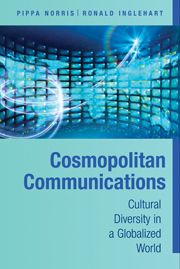Book contents
- Frontmatter
- Contents
- Tables and Figures
- Acknowledgments
- INTRODUCTION
- PART I FIREWALLS
- PART II CONSEQUENCES
- 6 Citizens: National and Cosmopolitan Identities
- 7 Consumers: Economic Values
- 8 Morality: Traditional Values, Sexuality, Gender Equality, and Religiosity
- 9 Activists: Civic Engagement
- CONCLUSIONS
- Technical Appendix A: Concepts and Measures
- Technical Appendix B: List of Countries
- Technical Appendix C: Methods and Multilevel Regression Models
- Notes
- Select Bibliography
- Index
- Titles in the Series
8 - Morality: Traditional Values, Sexuality, Gender Equality, and Religiosity
Published online by Cambridge University Press: 05 June 2012
- Frontmatter
- Contents
- Tables and Figures
- Acknowledgments
- INTRODUCTION
- PART I FIREWALLS
- PART II CONSEQUENCES
- 6 Citizens: National and Cosmopolitan Identities
- 7 Consumers: Economic Values
- 8 Morality: Traditional Values, Sexuality, Gender Equality, and Religiosity
- 9 Activists: Civic Engagement
- CONCLUSIONS
- Technical Appendix A: Concepts and Measures
- Technical Appendix B: List of Countries
- Technical Appendix C: Methods and Multilevel Regression Models
- Notes
- Select Bibliography
- Index
- Titles in the Series
Summary
Theories of powerful media effects assume that a wide range of social values and behavioral practices are learned from the ideas and images conveyed by popular television entertainment, glossy magazines, Internet Web sites, music videos, consumer advertising, feature films, and news reports. Cultivation theory, developed by Gerbner and his colleagues, treats the mass media as one of the standard agencies of socialization, rivaling parents and the family, peer groups, teachers and religious authorities, and social norms operating within the local community and national culture. Socialization is a multidimensional process involving the acquisition of knowledge, attitudes, and values. In particular, cultivation theory suggests that frequent exposure to the mass media, especially television, leads to the internalization of its messages. Through this process, the media is thought to be capable of influencing moral standards, including attitudes toward the family, marriage, and divorce, orientations toward sex roles, support for gender equality, and tolerance of sexual diversity, and beliefs about appropriate ethical standards in public life, as well as of shaping broader religious values, beliefs, and practices. Regular exposure to messages conveyed by mass communications is believed to have a cumulative effect on moral values and behavior, particularly on impressionable young children and adolescents during their formative years as they transition to adulthood.
- Type
- Chapter
- Information
- Cosmopolitan CommunicationsCultural Diversity in a Globalized World, pp. 220 - 235Publisher: Cambridge University PressPrint publication year: 2009
- 1
- Cited by



